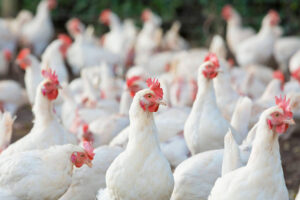THE farmgate price of chicken fell this month due to weak demand, according to the United Broiler Raisers Association (UBRA).
“The expectation of the industry (that) farmgate prices will be better… has not happened,” UBRA President Elias Jose M. Inciong said in a phone interview, describing the demand situation as ”very poor.”
UBRA estimated that as of April 21, the average farmgate price of regular-sized and prime broiler chicken fell 2.15% week on week to P91 per kilogram and 3.85% to P88.91 per kilogram, respectively.
According to Mr. Inciong, demand remained soft after Easter which led to a buildup in chicken inventory. He said farms usually expect prices to recover during hot and humid weather.
In Luzon, the production cost of chicken was pegged at P105-P115 per kilogram liveweight. Costs are typically higher in the Visayas and Mindanao, where the market prefers lower-weight birds.
“Therefore chicken’s cost of production be higher because you cannot dilute or distribute your fixed costs to more weight,” he said.
Asked on how long the farmgate price decline could last, he said demand remains certain but supply will depend on the weather.
“If there is an escalation in the price of rice, then normally in a household, rice would be the priority. Then demand for chicken and protein in general will decline,” he said.
Mr. Inciong said that the first and last quarters are usually periods of low farmgate prices due to oversupply, with chicken typically imported chicken for the holidays.
“The nature of imports is such that they only impact upon the farmgate prices and not much on retail prices for the consumers and that has only been the case,” he said.
During the first three months of the year, chicken imports hit 102.74 million kilograms, up 31.85% from a year earlier, according to the Bureau of Animal Industry.
He added that the industry is concerned about egg prices, which have not risen as much as expected.
“Considering that their capacity has been impacted by bird flu… they were expecting better prices by this time,” he said.
The BAI said on March 13 that H5N1 avian influenza has been detected in 153 barangays since early last year, with nine of the sites harboring active outbreaks.
Mr. Inciong said most Southeast Asian neighbors have decided to vaccinate, pointing to the need for the Philippines to do so as well.
“We should not be left behind, baka wala na naman tayo doon sa supply (Our supply could suffer). Like with the COVID-19, we’re at the end of the line in obtaining vaccines,” he said.
In a memorandum order dated April 17, Agriculture Senior Undersecretary Domingo F. Panganiban advised the industry that vaccines are still undergoing technical review.
He also cautioned against the use of unregulated vaccines, which could raise the risk of virus mutations and lead to the further spread of bird flu.
“Our position is since we do not have the capability to export at this point for various reasons, we might as well vaccinate and at least supply for domestic use will be assured.”
As of April 20, the prevailing price of a whole chicken in Metro Manila was P150-P200, according to the price monitoring report of the Department of Agriculture. — Sheldeen Joy Talavera
